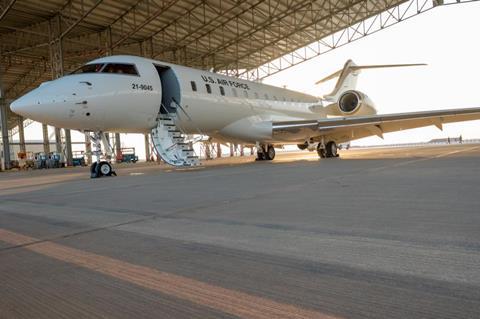The US Air Force (USAF) has added another airframe to its small fleet of highly specialised airborne communications jets, part of a plan to expand that capability.
The service’s Middle East headquarters on 2 January said it has begun operations with a Bombardier E-11, based on the company’s Global 6000 airframe.

Known as the Battlefield Airborne Communications Node (BACN), the E-11 is described by the USAF as “wi-fi in the sky”, that provides an airborne relay station to extend communication ranges, bridge different radio frequencies and “translate” between incompatible communications systems.
“BACN technology reduces line-of-sight issues by enabling real-time information flow across the battle space between similar and dissimilar tactical data link and voice systems through relay, bridging and data translation,” says the USAF.
Northrop Grumman provides integration, sustainment and support for the BACN programme.
E-11s are exclusively operated by the USAF’s 430th Expeditionary Electronic Communications Squadron, which is currently based at Prince Sultan air base in Saudi Arabia.
“This new E-11A will relieve the pressure on the rest of our fleet and enable us to sustain a high mission-capable rate,” says Lieutenant Colonel Todd Arthur, commander of the 430th Squadron. “Having an additional aircraft will give our maintenance team another option to reliably put combat air power into the skies.”
The USAF operates a small fleet of just four E-11 airframes, according to Cirium data.
The fleet previously operated from Kandahar airfield in southern Afghanistan during NATO’s 20-year war in that central Asian country. The US military developed the E-11 platform in 2008, following issues maintaining communications amidst Afghanistan’s mountainous terrain during the early years of the war.
The fleet saw combat service throughout the conflict. Unlike with other USAF aircraft, E-11 pilots are not specialised and are instead volunteers drawn from the ranks of other aviation specialities.
“We have fighter pilots, bomber pilots, transport pilots, tanker pilots, special operations pilots, trainer pilots, test pilots,” Arthur notes.
Although trained heavily on simulators, it is typical for a pilot’s first actual E-11 flight to be in combat operations, due to the small fleet size.
In January 2020, an E-11 crashed in Taliban-controlled Ghazni Province, killing the aircraft’s two crew. It was the last fatal aviation incident of the conflict for the US-led coalition.
Although the Taliban claimed credit for the aircraft’s downing, the USAF determined engine failure and subsequent pilot error were to blame. Video of the crash site obtained by the US government-funded Radio Free Europe/Radio Liberty shows catastrophic damage. The Aviation Safety Network confirmed the video’s authenticity.
The recent E-11 delivery is the first of up to six airframes the USAF can option under a 2021 contract. The service says it plans to add a second squadron of E-11s to bolster its existing capability.
“With the high mission success rates the E-11A has demonstrated in the Middle East, and the strategic capability advantages the aircraft brings to the joint force, the air force has announced plans to bring a new E-11A BACN squadron to Robins AFB, Georgia,” the USAF says.
The new unit will be administratively activated in February, according to Arthur. The USAF says its aim for the expansion is to “establish a more traditional model with one home station squadron and a deployed squadron”.
Additional E-11 deliveries are expected later this year.
Additional reporting by Greg Waldron


























